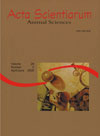<b>Effect of energy restriction for late finishing pigs on performance, carcass traits and environmental pollution</b> - DOI: 10.4025/actascianimsci.v29i2.223
Abstract
Two trials were carried out to study the energy restriction (3200, 2960 and 2720 kcal of ME kg-1) for late finishing pigs, by means of adding dietary fiber (ground rice hull). Experiment I - 36 pigs were used (69.39 ア 5.38 kg). The variables studied (performance, carcass traits and PUN) were separated according to the slaughter weight (70-90 kg and 90-115 kg). 12 pigs weighting 87.55 ア 3.12 kg and 15 pigs weighting 115.41 ア 6.20 kg were slaughtered. None of the variables studied were influenced by the different levels of ME. Experiment II -15 barrows were used (84.8 ア 4.5 kg) and kept on metabolism crates. There was a linear increase of total feces, dry matter (DM) and organic matter output, according to dietary energy reduction, without causing an increase in total phosphorous (P) and nitrogen (N) excretion. Digestibility coefficient of DM and crude protein decreased, which led to a decrease in daily weight gain and an increase in feed: gain ratio. Results suggest the possibility to slaughter high lean meat pigs, weighting up to 115 kg, without impairing performance and carcass traits, regardless dietary energy level. However, total feces output increased without causing an increase in N and P excretion, as ME decreased and crude fiber increased.Downloads
Download data is not yet available.
Published
2007-11-13
How to Cite
Moreira, I., Voorsluys, T., Martins, R. M., Paiano, D., Furlan, A. C., & Silva, M. A. A. da. (2007). <b>Effect of energy restriction for late finishing pigs on performance, carcass traits and environmental pollution</b> - DOI: 10.4025/actascianimsci.v29i2.223. Acta Scientiarum. Animal Sciences, 29(2), 179-185. https://doi.org/10.4025/actascianimsci.v29i2.223
Issue
Section
Nonruminant Nutrition
DECLARATION OF ORIGINALITY AND COPYRIGHTS
- I Declare that current article is original and has not been submitted for publication, in part or in whole, to any other national or international journal.
The copyrights belong exclusively to the authors. Published content is licensed under Creative Commons Attribution 4.0 (CC BY 4.0) guidelines, which allows sharing (copy and distribution of the material in any medium or format) and adaptation (remix, transform, and build upon the material) for any purpose, even commercially, under the terms of attribution.
Read this link for further information on how to use CC BY 4.0 properly.
0.9
2019CiteScore
29th percentile
Powered by 








































